Tom's Guide Verdict
With top-notch performance, a stunningly good rear camera and a unique, eye-catching design, the U11 is the best phone HTC has made in years.
Pros
- +
Class-leading performance
- +
Bright, 5.5-inch QHD display
- +
Fantastic BoomSound speakers
- +
Gorgeous design with IP67 water resistance
Cons
- -
Average battery life
- -
No headphone jack
- -
A bit bulky
Why you can trust Tom's Guide
I thought the HTC U Ultra, released earlier this spring, was an alluring phone in need of a bit more polishing. It seems HTC agreed, because its new flagship, the HTC U11, is here and it's better in almost every way.
Priced at $649, the HTC U11 features a big, bright, 5.5-inch screen; markedly faster performance; and a camera that rivals the best from Samsung and Apple, all while sporting a gorgeous, gem-like design. But the highlights don't stop there, because the U11 packs a total of four microphones, two voice assistants (with a third on the way) and built-in pressure sensors that let you open apps by squeezing the sides of the phone. After HTC produced a string of middling devices, the U11 is exactly what the company needed to remind people that it's still alive.
Updated June 9
- The HTC U11 is now shipping. It's also available in Sprint's retail stores now, according to HTC.
Availability
If you want to walk into a physical store to buy your phone, the U11 is only available at Sprint. However, if you buy online, you can get this phone unlocked. There are carrier-specific versions of the U11 for all the big providers on Amazon or directly from HTC.com.
Design: A symphony in glass
There's no shortage of glass-backed phones nowadays, but I defy you to you find one (aside from the U Ultra) that looks like the U11. For the U11's back, HTC started with a single flat sheet of Gorilla Glass 3 and squashed it into progressively curvier molds to form a smooth, rounded back that looks more like sci-fi jewel scarab than a piece of consumer tech.
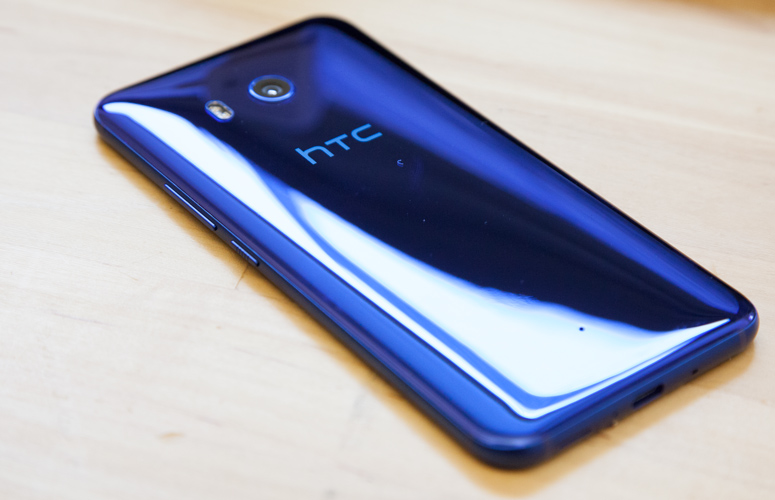
Below the display, you get a combo fingerprint sensor that also doubles as a capacitive-touch home button, along with two more touch buttons on either side, for Back and Recent Apps. The lock button on the right side sports a jagged texture, so you can recognize it by feel, while the smooth volume rocker sits above that. The U11's top edge features a removable SIM tray with space for a microSD card when you want to add some additional capacity to the U11's built-in 64GB of storage.
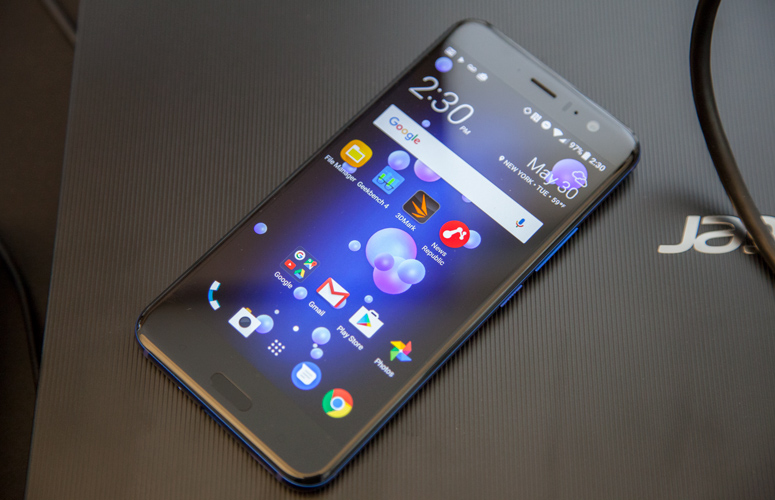
Some folks may take issue with the U11's sizable bezels on top and bottom now that we live in an age of super-skinny smartphone designs. But for me, the bigger issue is that the bezels on top and bottom are different widths. Had they been the same, the phone would look a little more balanced and a bit less bulky, though with its 5.5-inch display and 16:9 aspect ratio, the U11 was never going to be a truly compact device.
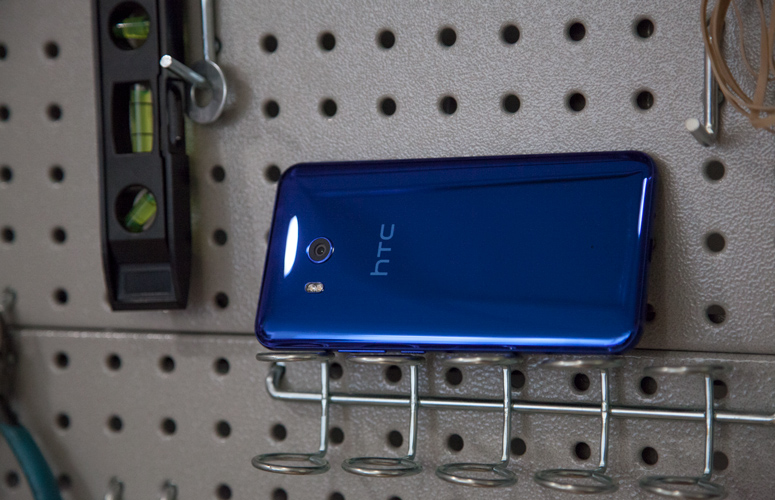
Measuring 6.06 x 2.99 x 0.31-inches and weighing 5.96 ounces, the HTC U11 is practically the same size as the Google Pixel XL (6.09 x 2.98 x 0.33 inches and 5.93 ounces). However, compare the U11 to the Galaxy S8 (5.86 x 2.68 x 0.31 inches and 5.47 ounces), and Samsung's flagship feels significantly smaller and sleeker. That's despite the S8 having a total screen area that's actually slightly larger, thanks to its 18.5:9 aspect-ratio display.
Get instant access to breaking news, the hottest reviews, great deals and helpful tips.
A simple squeeze of the U11's sides can open an app or even take a picture.
Like any good flagship smartphone in 2017, the U11 boasts IP67 water resistance, so you won't have to worry about any spills or dips in the sink trashing your device.
Edge Sense: Do we really need a squeezable phone?
Moto has its Moto Actions gesture commands, and Huawei has its Knuckle Sense shortcuts. But with Edge Sense, HTC might have the weirdest motion controls of them all. You don't make movements with your hands or draw letters on the screen; instead, the U11 features pressure sensors built into the sides of the phone, so a simple squeeze can open an app or even take a picture.

By default, Edge Sense is set to open the camera when you squeeze the phone, but you can reprogram the feature to open pretty much any app on the device or toggle functions like the flashlight or Wi-Fi. Depending on what you choose, Edge Sense even has a bit of contextual smarts, letting you perform different tasks with the same simple action. For instance, you can open the camera on the first squeeze and then snap a pic on the second. Edge Sense's advanced settings will also let you add a second function for when you squeeze and hold the phone.
The 5.5-inch QHD display delivers on the three most important qualities of a good screen: brightness, color and accuracy.
The best use of Edge Sense is probably for taking a selfie, since your hands will likely be in the correct position to give the phone a little hand hug. However, I've found that even when Edge Sense's was set to its most sensitive pressure setting, trying to squeeze the phone while posing for a shot caused the device to shake more than if I had just tapped on the screen. In fact, the action of squeezing the U11 makes holding the phone that much trickier. While it didn't happen to me, because I went out of my way to be super careful, I wouldn't be surprised to hear about people dropping the U11 while trying to squeeze it.
MORE: Best Smartphones on the Market Now
Display: Big and bright
The 5.5-inch QHD display on the HTC U11 keeps things simple and delivers on the three most important qualities of a good screen: brightness, color and accuracy. You don't get pure blacks like you would on a phone with an OLED display (such as the Pixel or Galaxy S8), but the U11 still offers pretty solid contrast.
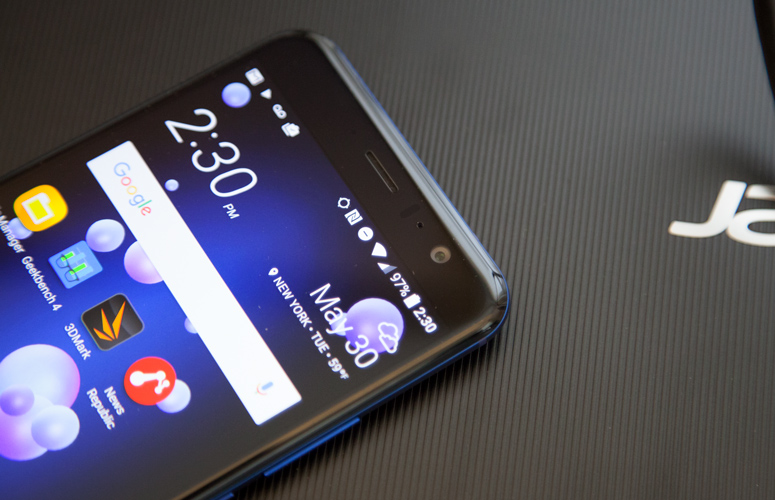
Initially, the U11 had a somewhat cool color casting that accentuated blues and downplayed warmer tones, but a quick trip to the phone's color-temperature setting makes it easy to adjust the screen however you want. In practically no time, I had the crimson and neon green blaster bolts shooting out from the X-wings and TIE fighters in The Last Jedi trailer looking exactly how I wanted. That's a nice bit of customizability that not every phone offers.
With the adaptive brightness on, we got the HTC U11 to hit a peak output of 512 nits. That puts it a fair bit ahead the Galaxy S8 and Google Pixel XL, which hit 437 nits and 396 nits, respectively.
With its stereo BoomSound speakers and noise-cancelling headphones, the HTC U11 offers the best overall listening experience of any phone on the market.
The U11 also earned some of the highest marks for color accuracy we've seen in recent history, as it notched a Delta-E rating of 0.34 (numbers closer to zero are better). The S8 was equally as good, with a rating of 0.36, while the Pixel was pretty far off, at 5.88.
As for color range, the U11's LCD display didn't fare quite as well as some of its AMOLED-equipped competition. Still, with a gamut that covered 166 percent of the sRGB spectrum, the U11 wasn't that far off the respective 183 percent and 191 percent tallies of the Galaxy S8 and Google Pixel XL.
Audio: Punchy stereo speakers, but no headphone jack
With its stereo BoomSound speakers and included noise-cancelling headphones, the HTC U11 offers the best overall listening experience of any phone on the market. But there's one big downer: Like other recent HTC phones, the U11 lacks a headphone jack.
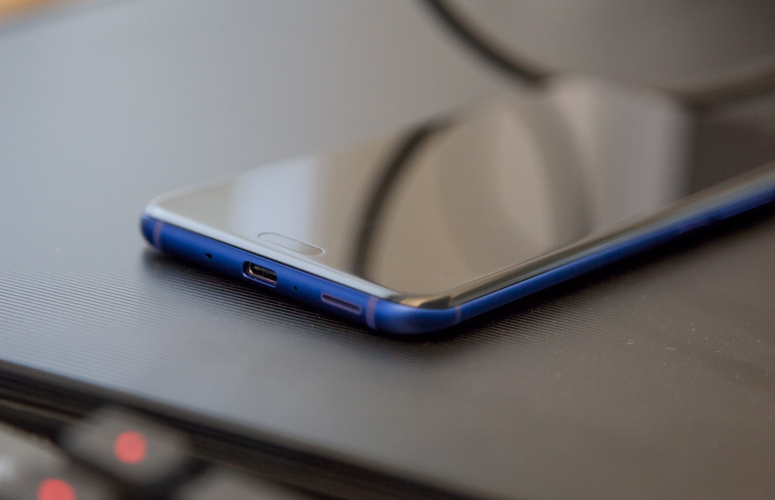
The U11's BoomSound setup uses the bottom-firing speaker in tandem with the earpiece to put out a truly impressive amount of sound. The feature makes phones with single-speaker setups, like the Galaxy S8, sound embarrassingly bad, and when you put the U11 up against phones, like the iPhone 7, with similar two-speaker arrangements, the U11 stills wins on both volume and sound quality.
MORE: Best Cheap Unlocked Smartphones
When you want to listen to things a bit more privately, HTC includes a pair of special USB-C earbuds that automatically create a personalized audio profile specifically tuned for your ears. On top of that, HTC uses the tiny mics built into the earbuds to provide true noise cancellation, which should be a big boon to anyone listening to music on a plane or train. I also appreciate how HTC includes three different size tips for its earbuds to help ensure a better fit.
The U11's 12-megapixel rear camera produced stunning shots, putting HTC on an equal footing with camera phones from Apple, Google and Samsung.
But there's a downside: Even though HTC has thoughtfully included a dongle so you can still use your old-school headphones, the adaptive audio and noise-cancelling tech needs both the USB-C audio processing and HTC's custom earbuds to function. In other words, those special features won't work on third-party headphones.
Cameras: New heights for HTC
It seems like HTC has been promising big things from its Ultrapixel cameras forever, and on the U11, the company has really delivered. The U11's 12-megapixel rear camera produced stunning shots, putting HTC on an equal footing with phone cameras from Apple, Google and Samsung. I especially liked some of the low-light shots I got, which looked noticeably brighter and less grainy compared to images from the S8.
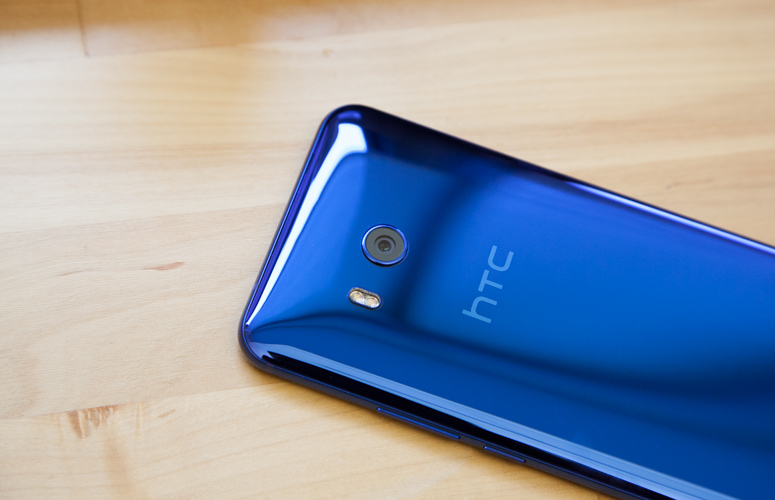
During the daytime, the U11 also wowed, offering a more restrained counterpoint to the super-rich and saturated shots captured by the Galaxy S8. On the front, though, the U11's 16-MP selfie cam was less compelling than I hoped.
The Flower Shot
A picture of a flower can tell you a lot of things about a camera, and while neither the Galaxy S8 nor the U11 nailed it 100 percent, HTC's phone still impressed. This comparison exposes the S8's tendency to oversaturate colors, which resulted in unnaturally vivid magenta petals instead of the softer pink tones you see from the U11. The S8's picture is just a tad sharper, though a few areas could be called oversharp.
The Food Shot
In the contest to see which phone shoots a better burger, the U11 came out on top. It's close, but the U11's pic looks warmer; features more-accurate colors; offers better details in the bun, bacon and onion rings; and simply made the sandwich look more delicious. In fact, when I asked my co-workers to pick which phone's photo they prefered, every single person chose the U11's pic.
The Outdoors Shot
In the last of the daylight comparisons, the S8 hit back hard with a shot that beat the U11's pic in almost every aspect: color, sharpness, detail, you name it. The S8's pic even did a better job of preserving the baby blue sky in the background.
The Low-Light Close-Up Shot
At night, when I took a minute to snap my growing family of plushies, the U11 showed some serious low-light skills, producing a better-exposed, less grainy picture than the Galaxy S8 did. Meanwhile, the S8's shot looked overly yellow, and without the S8's pic as a comparison, you might not even know this was a low-light shot at all.
MORE: Galaxy S8 vs. iPhone 7 Camera Shootout: Samsung Has the Edge
The Outdoors Low-Light Shot
In even less light, the U11 once again wowed, with a nighttime shot that's noticeably brighter and less noisy than the S8's photo. In the S8's image, you lose a lot of detail in the darker sections in the foreground, and the overly yellow white balance give the plants a sickly, unpleasant appearance.
In general, I found that the U11 outperforms the S8 is many low-light scenarios, though results can vary. When I walked just a bit farther and took a shot of a nearby pool, the S8's shot was clearly superior, as the U11's photo showed worse exposure and white balance.
Selfies
With a 16-MP front cam that captures double the resolution of the Galaxy S8, you might expect the U11 to come out firmly ahead. However, that wasn't the case. Quite often, the S8's front camera produced sharper, more-detailed photos than the U11 did. Yes, the background in the U11's pic is better-exposed, but if you look at things like my hair or shirt, it's clear how much better the S8's pic is.
Performance: As fast as it gets
When you combine Qualcomm's powerful Snapdragon 835 processor with 4GB of RAM and 64GB of storage, you get some of the best performance on a smartphone available right now.
On Geekbench 4, which measures overall system performance, the U11 posted a score of 6,493; that's slightly higher than what we got from the Samsung Galaxy S8 (6,124). Meanwhile, Google's Pixel XL and its Snapdragon 821 processor performed 35 percent worse, with a score of 4,146.
It was the same story for web performance, where the U11 scored 70.52 on the JetStream 1.1 JavaScript test. The Galaxy S8 was only slightly behind, with a score of 67.5, while the Google Pixel XL was pretty far back, with a score of 55.93.
MORE: Galaxy S8 vs. iPhone 7: Which Phone Is Really the Fastest?
The U11's graphics performance was also quite impressive. On 3DMark's IceStorm Unlimited test, the U11 hit 40,946, versus 35,903 for the Galaxy S8, and just 28,182 for the Pixel XL.
Software: Two digital assistants with one more on the way
HTC has maintained a pretty light touch on Android 7.1, so that its Sense UI will look instantly familiar to anyone with even the slightest knowledge of Google's mobile OS. Some small differences include the BlinkFeed news app that appears when you swipe right from the home screen; that's normally where Google Now cards live. The HTC U11 also features a more traditional icon for the app drawer instead of the minimalist app launcher you'd get on a Pixel.
The one big addition HTC tacks on is its Sense Companion, which is another digital assistant that works alongside the built-in Google Assistant. The two assistants have a lot of overlapping features, including the ability to set reminders or notify you when you're near a place of interest, but Google's assistant still has the clear lead in search and answering questions.
The Sense Companion is actually more like a digital secretary, as it may remind you to recharge your phone in the afternoon so you won't run low while attending meetings at night. Or it may tell you that you need to step up your activity, after noticing a lower-than-normal step count earlier in the day.
In practice, I found that just letting the Sense Companion do its thing was a helpful but not essential tool for better personal and device management. But when I had a question I needed answering, Google is still the one I asked for by name.
Coming sometime this summer (think early July), Alexa will also make an appearance on the U11. Unlike with half-baked attempts to incorporate Amazon's voice assistant into other phones, which require you to physically open an app before voicing your request, using Alexa on the U11 should be exactly the same as talking to an Amazon Echo or Dot. However, since Alexa wasn't available on our review unit, we're not sure how the assistant will perform.
Battery Life: Pretty good but not great
The U11 has more than enough battery life to last a full workday. However, as battery life on smartphones continues to improve across the board, the U11's longevity doesn't really stand out.
On the Tom's Guide Battery Test (continuous web surfing using Sprint 4G LTE), the U11 lasted 9 hours and 38 minutes. That's just marginally better than the 9:32 smartphone average and an hour to an hour-and-a-half less than the times for competing flagships, such as the Galaxy S8 (10:39) and the Google Pixel XL (11:11).
MORE: Smartphones with the Longest Battery Life
When it comes time to recharge the phone, the U11 features Qualcomm Quick Charge 3.0, which can recharge the phone to over 50 percent in 30 minutes. Strangely though, the U11 doesn't have support for Quick Charge 4.0, even though all Snapdragon 835 devices should have support for Qualcomm's newer charging standard. Unfortunately, for those who don't want to deal with wires, the U11, does not support wireless charging.

Is This HTC's True Flagship?
The availability of both the U11 and U Ultra may cause some confusion, as to which phone is HTC's best foot forward. The HTC U Ultra has the higher price tag, but the U11 is better in most aspects. It has the more powerful mobile processor in the Snapdragon 835, and it lasts longer on a charge than the U Ultra. The main reason to choose the U Ultra is if you demand a big-screen phone, as the U Ultra's 5.7-inch display is slightly larger than the 5.5-inch screen on the U11.
Bottom Line
HTC can keep its Sense Companion and its squeezable Edge Sense controls. Those features work as advertised, but I don't need 'em. The things that really makes the U11 stand out are its unique jewel-like design, thumping BoomSound speakers, superb performance and a rear camera that can keep pace with the best from Apple, Google and Samsung.
However, even though the Galaxy S8 costs $100 more, I still have to give a slight edge to that phone, due to its more one-hand-friendly design, better display and longer battery life. The S8's headphone jack is nice, too. Still, it's a close call, made even closer by features like the U11's noise-cancelling earbuds and forthcoming Alexa integration, which could both convince you to side with the U11. And if they did, you'd be making a solid choice, because the U11 is the best phone HTC has made in the last five years.
Photo credit: Shaun Lucas/Tom's Guide. Comparisons: Sam Rutherford/Tom's Guide.
Sam is a Senior Writer at Engadget and previously worked at Gizmodo as a Senior Reporter. Before that, he worked at Tom's Guide and Laptop Mag as a Staff Writer and Senior Product Review Analyst, overseeing benchmarks and testing for countless product reviews. He was also an archery instructor and a penguin trainer too (really).
-
Freevolt Guys, tell someone who bought this miracle of technology, or perhaps kept it in their hands. I have Samsung galaxy s6, will htc u 11 be a worthy replacement, and if it costs its money, is it not much more than $ 1200?Reply -
Domain Rider Not sure the selfie shots are really comparable, given that each is at a different angle to the sun...Reply -
redshirt58 Sam, great review . . . BUT, again, PLEASE state whether battery I'd removable.Reply
Yes, I realize most are not & my next phone, therefore, well likely be one of the cheaper or older models. Still, I'm keeping my Galaxy S4 (my Note 4 died) until it dies and/or I find something reasonably priced WITH a removable battery. -
rutherfordsc Reply19803061 said:Sam, great review . . . BUT, again, PLEASE state whether battery I'd removable.
Yes, I realize most are not & my next phone, therefore, well likely be one of the cheaper or older models. Still, I'm keeping my Galaxy S4 (my Note 4 died) until it dies and/or I find something reasonably priced WITH a removable battery.
Unfortunately, the battery on the U11 is not removable. -
rutherfordsc Reply19782928 said:Monaural not stereo... unfortunately, I've got no choice but to hang on to my M9
The U11 does have stereo speakers. There's one speaker on the bottom, and one in the earpiece. They just aren't both true front-facing speakers like on past HTC phones.
